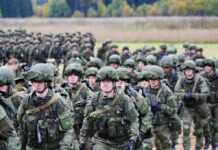
America’s withdrawal from Syria has created a catastrophic security vacuum that ISIS is exploiting to launch deadly attacks and rebuild its terrorist network, threatening regional stability and national security.
Story Snapshot
- ISIS attacks in Syria surged to 117 incidents by August 2025, already surpassing all of 2024’s total of 73 attacks
- U.S. military withdrawal in early 2025 left Kurdish forces and weak interim government unable to contain terrorist resurgence
- Major ISIS suicide bombing at Damascus church in June 2025 killed 22 civilians, demonstrating operational capability
- Counter-terrorism experts warn of “reigniting caliphate” as security gaps enable ISIS recruitment and territorial expansion
Biden’s Withdrawal Creates Terror Vacuum
The Assad regime’s collapse in late 2024 and America’s subsequent military drawdown created the perfect storm for ISIS resurgence. U.S. forces, who previously supported Kurdish-led Syrian Democratic Forces in containing the terrorist group, reduced their footprint significantly in early 2025. This withdrawal mirrors the disastrous 2021 Afghanistan pullout, abandoning local allies and creating ungoverned spaces where extremists thrive. The interim government led by Hayat Tahrir al-Sham lacks legitimacy and resources to fill the security void.
Watch: Syrian Govt.-Backed, U.S.-Backed Forces Reach Ceasefire In Parts Of Syria
ISIS has capitalized on this chaos with ruthless efficiency. The terrorist organization launched over 117 attacks across northeast Syria between May and August 2025, compared to just 73 attacks in all of 2024. These operations include sophisticated bombings, targeted assassinations, and recruitment drives in poorly secured detention camps. The June suicide bombing at Mar Elias Greek Orthodox Church in Damascus, which killed 22 worshippers, demonstrated ISIS’s renewed capability to strike high-value civilian targets.
Kurdish Allies Abandoned Again
Syrian Democratic Forces, America’s most reliable counter-terrorism partners, now struggle without U.S. backing. These Kurdish-led militias previously contained ISIS through coordinated operations and intelligence sharing with American forces. Their weakened position allows ISIS sleeper cells to operate freely while arms depots remain unsecured. The SDF faces the impossible task of guarding thousands of ISIS detainees in overcrowded camps while simultaneously combating renewed terrorist attacks across multiple fronts.
Multiple militia groups operate with limited coordination, creating exploitable gaps in security coverage. The fragmented command structure enables ISIS to move freely between territories controlled by different factions. Counter-terrorism experts from the International Centre for Counter-Terrorism warn that current security gaps and a crippled justice system provide optimal conditions for ISIS expansion.
National Security Implications Ignored
This ISIS resurgence threatens American homeland security as the group rebuilds its international terror network. History demonstrates that ungoverned territories become launching pads for attacks against Western targets. The 2011 U.S. withdrawal from Iraq similarly enabled ISIS’s initial rise, resulting in global terrorism campaigns and massive refugee crises. Current intelligence assessments indicate ISIS is actively recruiting foreign fighters and reestablishing communication networks that could facilitate international operations.
Regional destabilization affects key American allies including Turkey, Jordan, and Iraq, who face increased refugee flows and cross-border attacks. The humanitarian crisis deepens as Syrian civilians flee renewed violence, creating additional strain on neighboring countries and potential immigration pressures on Europe and America. President Trump now inherits this security nightmare, requiring either renewed military engagement or accepting the consequences of ISIS’s territorial expansion in a strategically vital region.
Sources:
Timeline: Islamic State’s attempts to regain power after being pushed out of Syria
Timeline: Islamic State’s attempts to regain power after being pushed out of Syria
Wilson Center Syria Program
ICCT Live Briefing: Reigniting Caliphate – ISIS Resurgence, Security Gaps and Rule of Law
Will the Shake-Up in Syria Undermine the Fight Against ISIS?
Fact Sheet: President Donald J. Trump Provides for the Revocation of Syria Sanctions

























